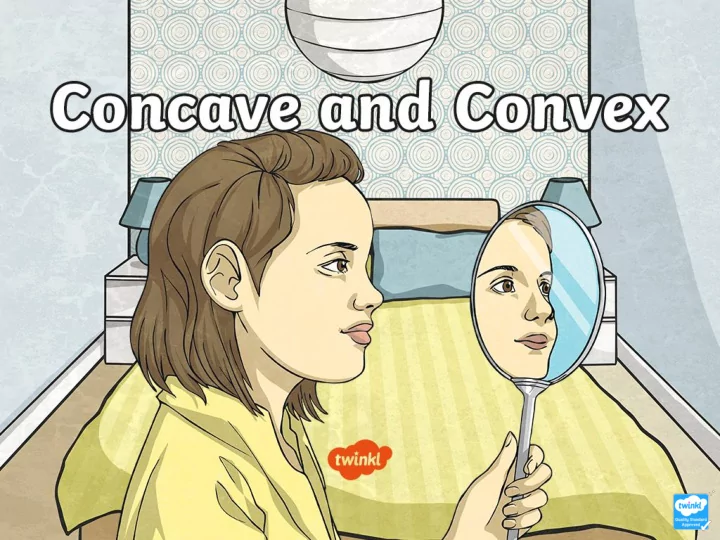

Aim Aim • To investigate how images change in concave and convex mirrors. Success Criteria Success Criteria • Statement 1 Lorem ipsum dolor sit amet, consectetur adipiscing elit. • I can identify concave and convex mirrors. • Statement 2 • I can ask questions about the size of images in concave and convex mirrors. • Sub statement • I can carry out an investigation and record data to answer my question. • I can explain how concave and convex mirrors change images.
House of Mirrors Have you ever seen a House of Mirrors at a fair or amusement park? People enjoy looking at their strange distorted reflections in the different mirrors. But what is special about these mirrors that enable them to change people's images?
House of Mirrors These mirrors make use of concave and convex mirrors. Convex mirrors bulge outwards, like Concave mirrors bulge inwards (like this: you go into a cave!) like this:
House of Mirrors Concave and convex mirrors reflect light differently to plane (flat) mirrors, so your image looks different in these types of mirrors. Today, you are going to investigate exactly how concave and convex mirrors change our images. Look at yourself in the back of a spoon – this is a convex image. Turn the spoon over and look into the ‘dish’ of the spoon – this is a concave image.
Why Does This Happen? Images appear different in concave and convex mirrors because the way the mirrors bend causes the mirrors to reflect rays of light in different angles. Watch the ways the rays of light are reflected differently.
Why Does This Happen? A concave mirror reflects A convex mirror reflects the light rays in towards rays of light at a wider a point. From far away angle towards its edges, A plane mirror reflects the object will appear creating a slightly the rays of light back in a upside down, but as you distorted image that straight line, so images move nearer and reach appears smaller than appear the same as they the focal point, the image actual size. The smaller are in real life. flips the right way up size of the image means and magnifies, so that that we can see more in the image appears larger these mirrors. than actual size.
Concave or Convex? A car wing mirror is a convex mirror. Why is a convex mirror the best choice? A convex mirror makes objects appear smaller so you can see more widely than you would normally be able to. This means drivers can see more of the road, so they are safer. • It is thought that car wing mirrors were invented by a man named Arthur James Wilson. • Arthur Wilson was a famous cyclist. He was born in 1858, and raced in many competitions in the 1870s. One year, he cycled 3200 miles in races! • Although he was born able to hear, Arthur went deaf at the age of 12 after contracting scarlet fever. In 1896, he was the first deaf British person to buy and drive a motor vehicle.
Concave or Convex? People believe that Arthur Wilson went on to invent car wing mirrors, and he became wealthy. He made friends with the Prince of Wales and taught King George V to cycle!
Concave or Convex? Convex and concave mirrors reflect light in different ways to create different images. Scientists and inventors have used them in many different devices and for different purposes. Look at these examples and decide whether they are convex or concave mirrors. Why have these mirrors been chosen for their purposes?
Concave or Convex? concave mirrors convex mirrors
Aim Aim • To investigate how images change in concave and convex mirrors. Success Criteria Success Criteria • Statement 1 Lorem ipsum dolor sit amet, consectetur adipiscing elit. • I can identify concave and convex mirrors. • Statement 2 • I can ask questions about the size of images in concave and convex mirrors. • Sub statement • I can carry out an investigation and record data to answer my question. • I can explain how concave and convex mirrors change images.
Recommend
More recommend